10 Steps to Self-Publishing Success
I want you to know how easy this is, because the internet can be a confusing place, distorting the simplicity of making money from your creative work. Also, opportunities come and go, and it's very hard to gauge whether opportunities in the world of self-publishing are legitimate or not. I'm here to tell you that you can write and widely publish a book with zero marketing budget. You can do this, and here's how. I welcome questions about this process and ask that you please post them as a comment on this blog post. That way, other people can learn from your question. I promise, if you are curious about something or confused by something, someone else shares your query.
Let's get started.
When deciding to become a published author, I saw two possible paths:
1. Write a book proposal (a new skill for me that would've meant hours of learning), and send query letters to dozens of publishers, hoping that some intern would select my proposal from the slush pile and think "yeah, minimalism for grandparents!" I could wait months or even years for a book deal, and then finally get one, eventually signing a mediocre contract allowing me a small cut of the profits.
2. I could get started writing the book right away. I could spend my precious time on this planet writing valuable content for thousands of people, not proposals or query letters that one person would see, if I was lucky. I could have my books in the hands of my intended audience in less than a year through self-publishing. I could use the magic of the internet for free promotion and then keep a large portion, or all of the profits.
Obviously, I chose #2.
And I've been so glad that I did. It's outrageous that would-be authors are expected to spend hours of their time sucking up to publishing executives -- an impossibly narrow bottle neck. It's not a system that allows quality to get through. It's a system that is almost entirely lottery.
Did you know that the average nonfiction book published (self-published or traditional) in the US sells only about 250 copies per year? My books are now in the hands (more accurately, on the Kindles and iPads) of about 20,000 people. And that's just the number from the past 3 months. Not all of those people bought my book. Most got it for free. That means my royalties are modest. I just checked my royalties for the past 7 days -- $300. Although as far as I can tell, my royalties have been increasing steadily by month, after a tiny launch in December 2013. Royalties only show signs of increasing as more and more people read by book and tell their friends about it.
Several hundred dollars coming in month after month could be a life-changing, attitude changing, game-changing amount for a first-time author who needs some encouragement that his or her book royalties can eventually ramp up to form a full-time income.
Search the web for "self-publishing advice" and you'll instantly be confronted with lugubrious warnings about the outlook for self-publishers. The main problem? No one buys your book because no one knows about it. The idea is that traditional publishers, with their large marketing budgets, can bring your book the attention it deserves. And for a few lucky books a year, the system works. But the sad reality is that for the average author, the system fails. The publishers fail to do enough to put books in enough hands to create the best marketing: word-of-mouth.
So how did I get my book out to 20,000 + people when my marketing budget was about nill?
I'm here to save lives and careers.
I'm ready to share the secret, so that other first-time authors can quit chasing the rainbow of publishing houses and start changing lives with their writing. Rejection used to be a normal part of the job for authors. Collecting rejection slips may be responsible for the high rate of alcoholism and suicide among writers. More poignantly, I believe it causes most budding writers to just give up. So I'm here to save lives and careers. I want you to express your creativity, to create a work that will speak to someone, and I want you to get it out there into the world as soon as possible. Here's how.
The Step-by-Step Process:
1. Write your book.
It has to be good. The only way to tell if it's good is to get feedback from others, so gather a team of supportive yet honest beta readers who are interested in your topic or genre.
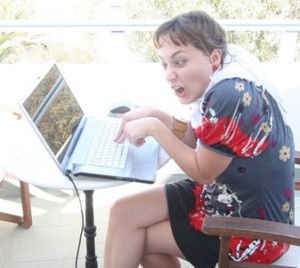
2. Rewrite your book.
Re-write your book keeping the feedback of your beta readers in mind, but ultimately listening to your own intuition. (Not your ego. Learn the difference.)
3. Have someone else copy edit your book.
Don't do this yourself, even if you're a professional copy editor. You won't be able to see typos. It's not your fault. The brain is wired to skip over things it thinks it knows already, so you are incapable of seeing errors in your own text if you know what you intended to write.
4. Have a cover designed.
Look up the cover specifications for Kindle Direct Publishing and have a cover designed. I designed my cover myself because I didn't have the budget to hire a designer, but eventually I'll have it redone by a professional.
5. Upload your book using Kindle Direct Publishing.
I used Amazon Kindle Direct Publishing (KDP) to publish my books. Here's why:
- Even if your book is written in Microsoft Word, Kindle Direct Publishing (KDP) will format it into a .mobi file for easy reading on Kindle. This process takes about 15-30 minutes. You submit it for review, and 12 hours later people can purchase it on Amazon.com
- Other companies that let you get your electronic book out there (i.e, e-junkie and various book selling sites) do negligible marketing for you.
- The Amazon website internal marketing machine is more powerful than all other booksellers combined, especially if you use Kindle Select.
- Anyone in the US (and many other countries) can purchase your book, whether or not they have a Kindle.
6. Enroll your book in Kindle Select.
Kindle Select is an optional program within Kindle Direct Publishing that involves exclusivity with Amazon. You cannot sell or offer your book in electronic form anywhere else for the three months your book is in the program. (Or more, if you re-enroll, which I recommend.) It's completely worth it IF you are a beginning author with a small audience. Here's why:
- As I wrote above, none of the other booksellers are worth your time when you can instantly get your book to so many people through Amazon.
- Kindle Select allows you to run promotions and free days. They internally market your promotion days, so that hundreds or thousands of people download your books, leading to the all-important word-of-mouth affect.
- You get higher royalties on international sales.
- Enrolling in Kindle Select also means people enrolled in the Kindle Owners Lending Library program can borrow your book for free, allowing your book to get into even more hands.
When might Kindle Select not be worth it? When you already have a large email list of thousands of eager fans ready to buy your book. In that case, you may be better off selling your book directly to your fans and keeping 100% of the profits. Even then, you may want to enroll your book in Kindle Select after you've offered the book directly to your audience for a few months and given them the first opportunity to buy it. This will allow you to reach even more people while still having your initial launch be to your biggest fans and best customers.
7. Run free days promotions.
You can run two types of promotion on with Kindle Select: free days and discount days. I have only experimented a little with discount days because free days seem to be working so well. You want to schedule your free days for at least two weeks in advance so you have time to build excitement and spread the word in your community.
8. Publicize your free days to book lovers.
While Amazon will do some internal marketing for your book, you want to give your free days the best possible shot at reaching a huge audience. Again, I'm on a budget, so I look for free ways to do this. My favorite is the Author Marketing Club. With a free membership, you can use a tool they have that lists a bunch of websites for book lovers. Use the tool to reach out to the folks who run these websites, tell them about your free day, and often they will tell their audiences about it. Many of these websites have a simple form you fill in with your book's information. For others, you need to shoot them an email. Make sure you tell your personal network about your free day as well.
9. Edit your book anytime.
This is something I really love about KDP. If a reader points out a typo, or you think of something you left out of the book, it's really easy to upload an edited book document. You'll be done in 5 minutes, with no disruption to your book's listing on Amazon. After publishing Minimalist Living, I realized that I hadn't given people enough incentive to sign up for my email list on my website, so I edited it to include the benefits of signing up for my email list. My subscriptions increased. I can even go back and change the cover any time I want to.
10. Renew your Kindle Select enrollment, and keep having and promoting free days.
Authors consistently see a spike in sales immediately after free days. This is probably because a bunch of people hear about the book and are intrigued, but have missed the free days. Or because people get the book for free, and then recommend that their friends check it out. It's very important that free days are only occasional and very special. That way the integrity of the value of your book is maintained. Don't make the mistake of giving away your book too often. However, most people, I think, err on the side of not giving their book away enough, meaning that their book never gains traction. I think the Kindle Select program hits the right balance for you.
That's it!
That's it! It's that easy.
Problems with Amazon
I should add that while I love Amazon and the programs they have for authors, it hasn't been an entirely perfect experience. Amazon uses an algorithm to remove fake reviews, but it's flawed, so that sometimes real reviews get deleted too. This can be especially frustrating to a first-time author. You can go from having 5 reviews to having 2 without understanding why. Since reviews help you get more reviews, the beginning can be a little slow going if Amazon removes the few reviews you do have.
The second frustration I've encountered is that my book isn't available globally. It's available to those who hold a credit card based in a bank in the US, Canada, and a small group of other countries. This means that my friends in the Middle East can't download it. I'm not sure why, but I think it has something to do with local publishing laws.
Despite these problems, Amazon KDP is overwhelmingly worth it for self-publishing authors. It's so far above the competition that at this time, no other options are worth considering.
Sit Down and Write!
The hardest part of this whole thing, is of course, writing the book. Get to it!
My First Trip to Gaza
Foreword: I'm re-posting this old blog entry about my first trip to Gaza because somehow it disappeared entirely from Packing Lust, probably during the transition from my last blogging service to Wordpress, the one I use now. It's one of my favorites, so I was so sad when I thought it was lost to the void forever. (I didn't have a back up of the text, just the photos). However, Prince Charming managed to find an archive of it online, despite my deleting the old blog before I knew it had gone missing. "Nothing can completely disappear from the internet," he says. (I now back up my blog regularly.) This was originally posted December 18, 2012. Enjoy.
Entry at Erez
"You're not a journalist or anything, are you?" the Israeli soldier in the first booth at Erez Crossing Point asked.
"No." But will I write about what I see? Of course.
Until the New York Times picks up this blog, I am not a journalist. I am free to enter the Gaza Strip through the Erez Crossing thanks to Prince Charming's NGO-worker status and my status as his wife. And from this unique position, needing neither journalist's credentials, nor being blocked from writing by my organization (as Prince Charming is), I can simply tell you what I experienced on my first, short trip to Gaza.
Not that it was simple for me to get into Gaza. First, an employee at Charming's NGO got me coordination with the Israel government and a visa with Hamas, the governing body of Gaza.
We arrived at Erez Crossing on December 12th.
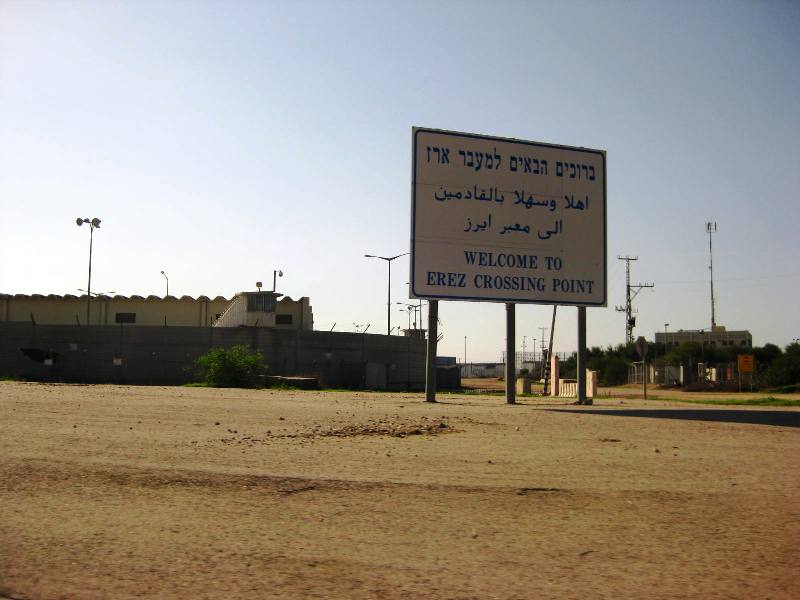
I put my camera away since there was a "no photography" sign at the entrance. The crossing looks like one modern, airy, new airport terminal. It's a large building with a lot of bullet-proof glass and shiny surfaces. We entered after a quick chat with the Israeli soldier who asked if I was a journalist. Then there was an interview with a passport control officer who shuffles papers and flips through every passport. Like many passport officers, she had shimmering, perfectly manicured nails. I think if I were a passport officer, I would too. The only thing there is for a would-be border-crosser to do as you shuffle, flip, and make phone calls is to stare at your hands.
At this point, I need to introduce Osama, one of Charming's colleagus in Gaza. Osama is a Palestinian who lives in Gaza and he is rarely allowed out of the strip. However, he was allowed to visit the West Bank for his job for the first time in a while, and when we went to Gaza, he re-entered with us to rejoin his family.
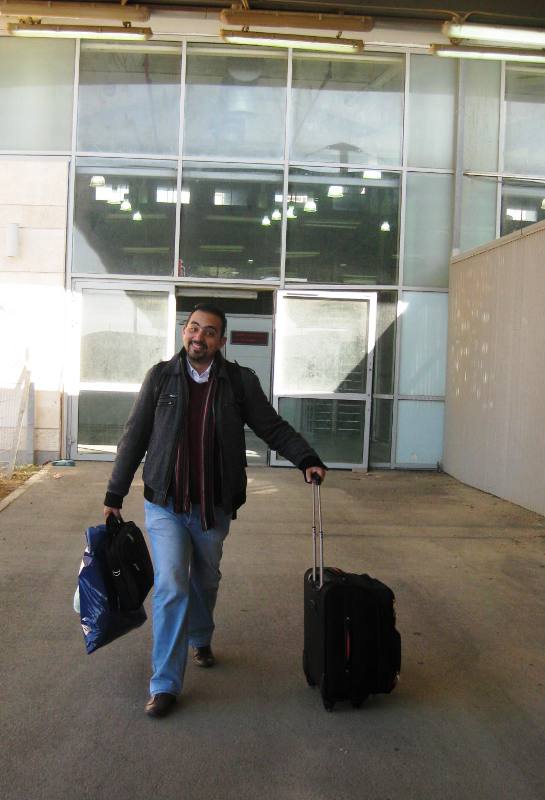 "Back to jail!" Osama said merrily as we entered Gaza.
"Back to jail!" Osama said merrily as we entered Gaza.
Once across the border, we caught a special golf cart we called a tuk tuk that took us across a kilometer of open land that acts as a sort of "no-man's-land" between Israel and the administration of the Gaza border.
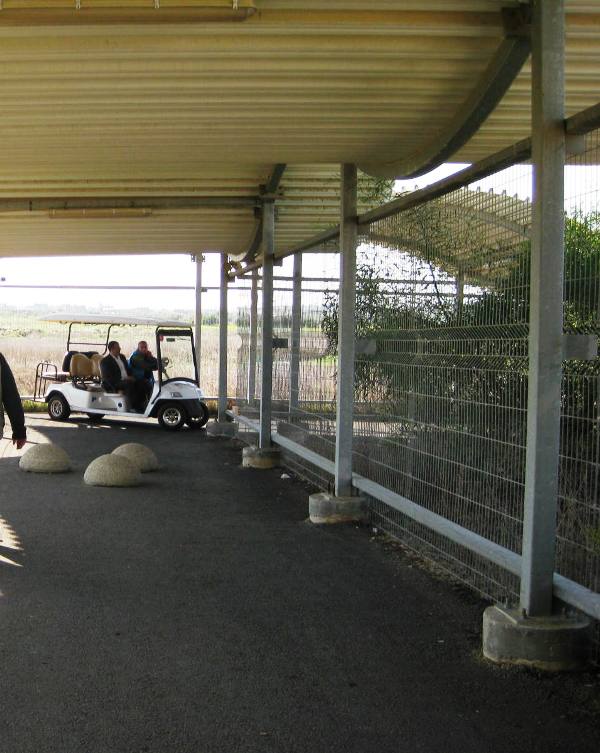
The covered path across no-man's-land.
The tuk tuk is officially for handicapped people, but if it's open, anyone can use it. Charming remarked that the tuk tuk driver has one of the weirdest jobs in the world. Can you imagine when someone asks "what do you do," saying "I drive a golf cart back and forth across the one kilometer separating two countries in conflict."
We then got out at a checkpoint known as Hamsa Hamsa or Five Five, in English. It's run by Fatah, the political party in charge of the Palestinian National Authority, which is the name of the government of Palestine. The Fatah checkpoint is only there because Israel won't talk to Hamas, the political party governing Gaza. Hamas is considered by Israel, the U.S., Canada, the E.U., and Japan to be a terrorist organization. While they seem more humane than other extremist Islamic groups, say the Taliban (who tried to kill Malala Yousafzai), it's their habit of firing rockets indiscriminately into Israel gets them labeled as terrorists.
After the buffer zone of Hamsa Hamsa, we reached Arba Arba (Four Four in English) by cab. Arba Arba is run by Hamas. We picked up our previously arranged paperwork and Hamas officials searched our bags. Cars from the Gaza office arrived and I met more Gaza staff members (of Charming's NGO).
During our twenty minutes at Arba Arba, a magical moment happened. 12/12/12 at 12:12. Charming and I got a photo to memorialize:
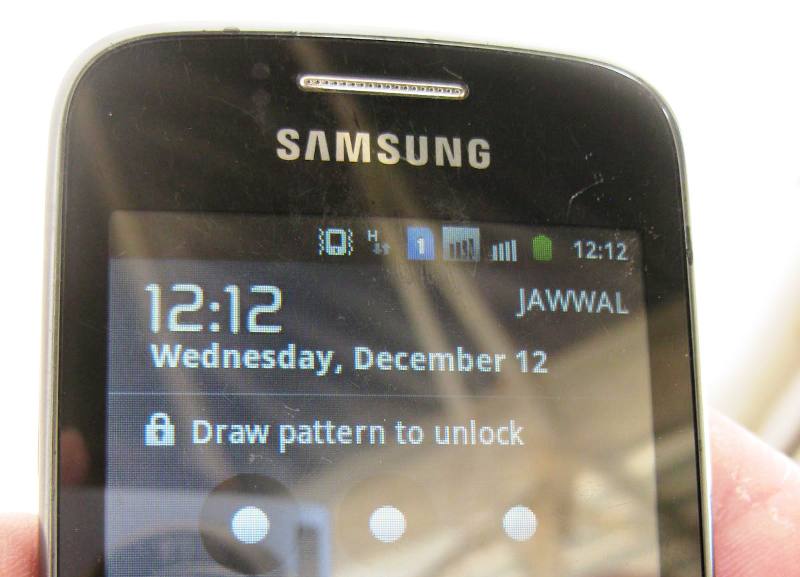
Gaza City
After these three different checkpoints, we arrived in Gaza City. Osama pointed out some of the destruction from the recent conflict. One thing that struck me was the precision of the attacks. Of course the Israelis made mistakes (see above note about children killed) but for the most part, (if we allow ourselves to sweep away the image of 35 dead children with that phrase) Netanyahu kept his promise when he said "...my government has instructed the Israeli Defense Forces to conduct surgical strikes against the terrorist infrastructure in Gaza."

A surgical strike in Gaza City.
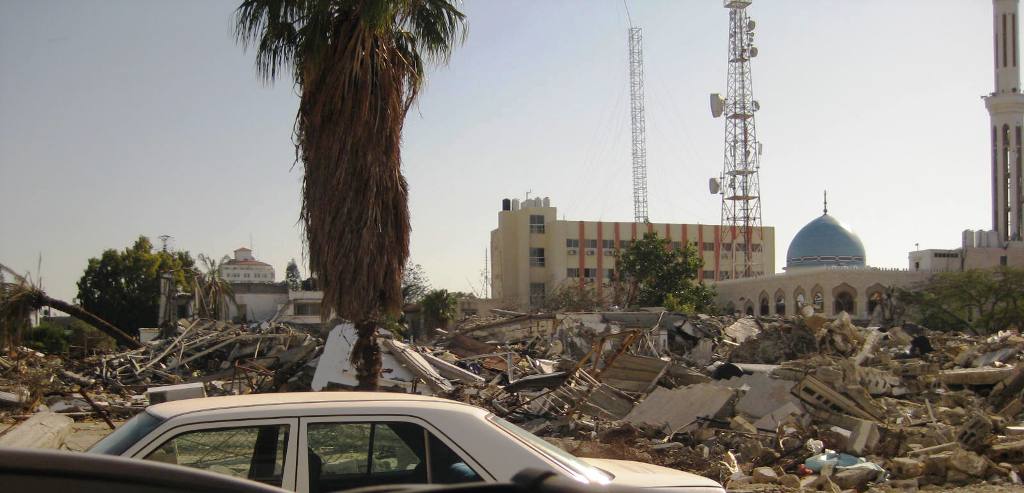
Another precision strike leaves a nearby palm tree and a mosque untouched.
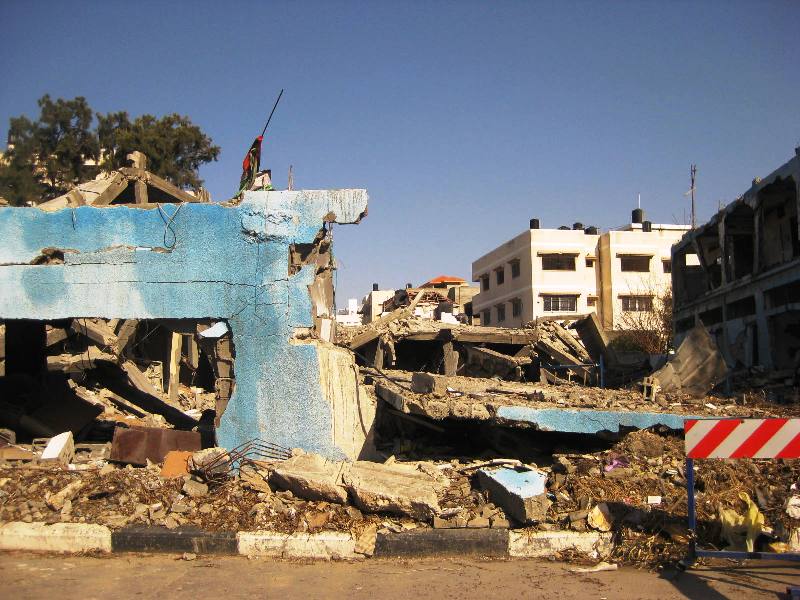
Destruction in Gaza City.
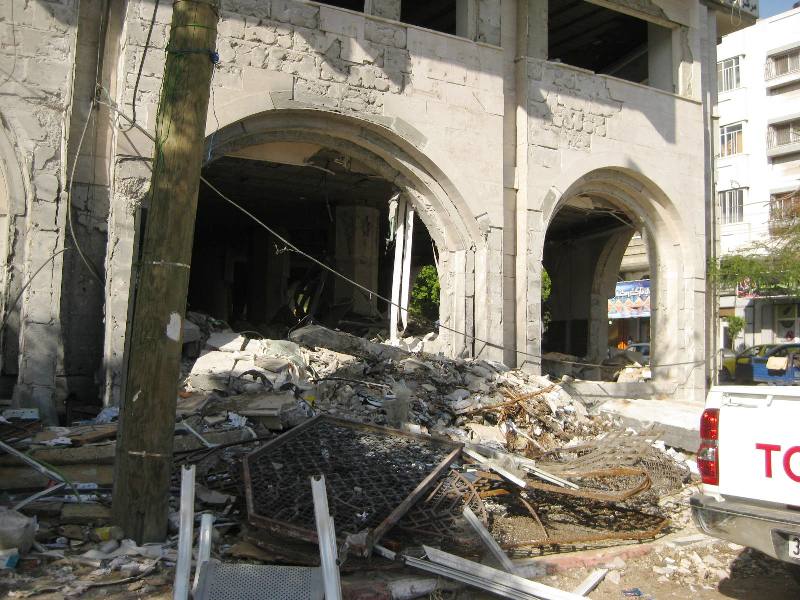
More wreckage in Gaza.
As we drove into the city, Osama greeted a fellow commuter he knew.
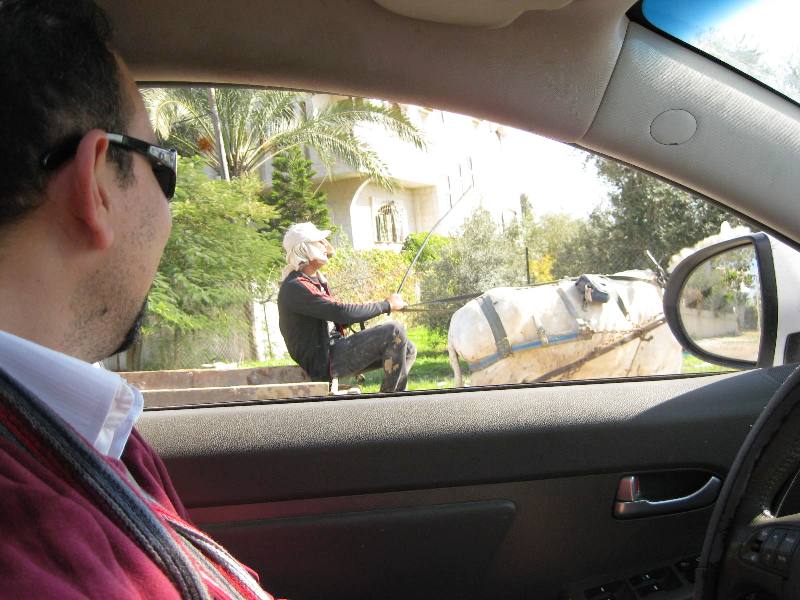
The people in Gaza use a lot of donkeys and horses for transportation and conducting business.
A special export of Palestine is the strawberry. When I tasted my first strawberry here, it was as if I had never tasted a strawberry before. Charming says the Dutch import them from Gaza and the fields are treated with great care and expertise.
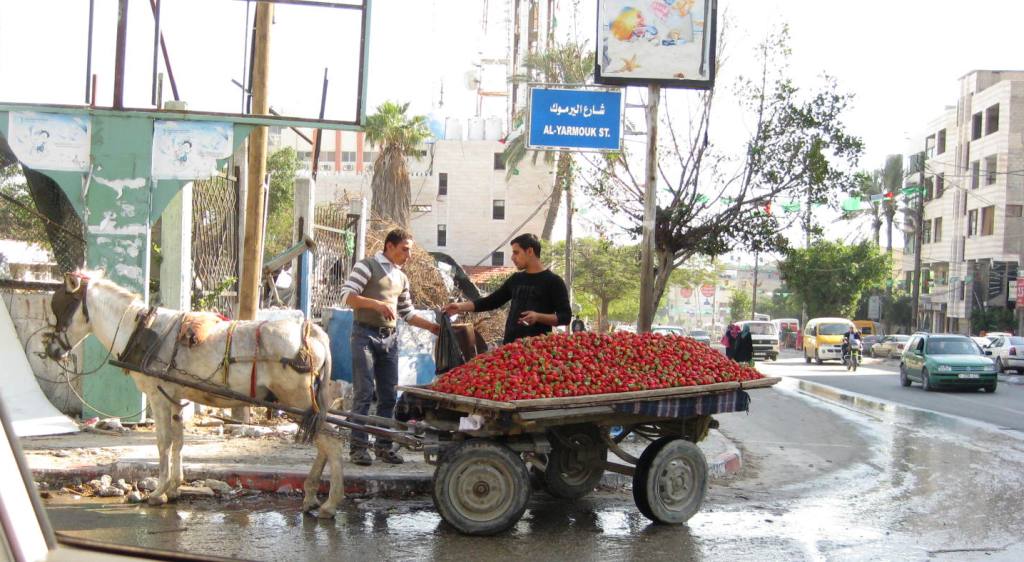
Once we arrived, Lulu, the office receptionist, kindly drove me around Gaza City so I could see the sights. Having already seen a lot of destruction, I was eager to see the beach.
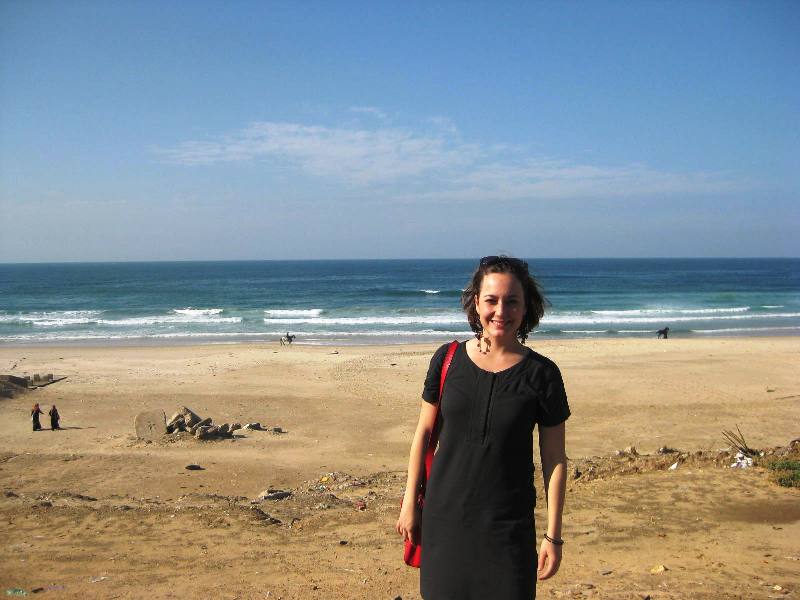
Enjoying the sight of the sea in Gaza.
It was lovely, this portion of the beach having had a walkway put in by Jawwal, our cell phone service provider. There were horses galloping along the water's edge. You can see them tiny in the background of the above photo.
But after that nice photo, I have to show you what happened before we saw the beach, before we had even left the street in front of Charming's office. As Lulu began to drive in front of Charming's organization, a group of men jumped out of a nearby car, and seemed to attack the car in front of us. Men jumped and were pulled out of that car. I didn't have time to feel scared. I snapped a couple photos.

Lulu, composure and smile perfectly intact, backed up, and turned off onto another street. I simply thought the incident it was a bit of road rage on the under-construction, traffic-clogged byway. It wasn't until writing this blog post that I noticed the large knife in the brown-jacketed man's hand in the second photo. Was this a car jacking? A car burglary?

The second photo.
Maybe this explains why, a bit later, Lulu said "you don't seem scared. Some foreigner are afraid to be here." I was thrilled to be somewhere warm and sunny with an ocean view. I didn't think much about the underbelly attributes of Gaza until I was out.
Lulu took me to her future home, a fourth floor condo still under construction.

Lulu in her future condo building.
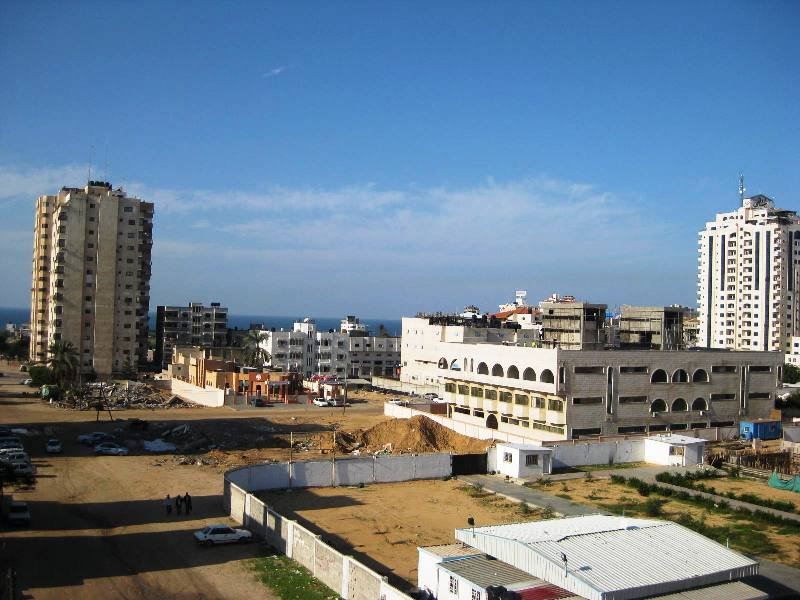
View from Lulu's future home.
We drove by the Gaza City fishing port.
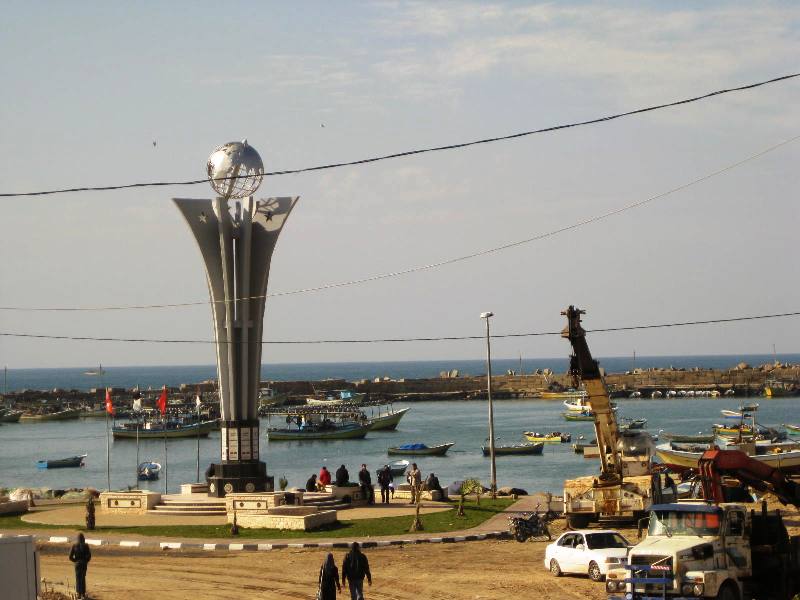
Like a scene out of a Tom Waits movie, near the center of town there was an abandoned circus. I wondered if I'd see a lion or trapeze artist roaming town, feeling lost.

Finally, my tour ended at Lulu's family home where I met her mother, two out of seven sisters, and her brother. We had coffee and cookies served on a tray decorated with hand-embroidered cloth.

Rafah
Later that evening, we drove with Osama and Arwa down the coast to Rafah, which is on Gaza's border with Egypt. Tunnels connect Rafah to Egypt, and Osama said "Everything you see came in through the tunnels." The streets were filled with the same early-model Mercedes that most of the population drove, making Rafah feel like we were in a movie set in the 60's.
On the way to Rafah, we stopped at a fish restaurant splendidly located with a view of the water. The only sign I saw said "Fish Frsh." Fish Frsh kept live fish in large pools fed from the nearby ocean.
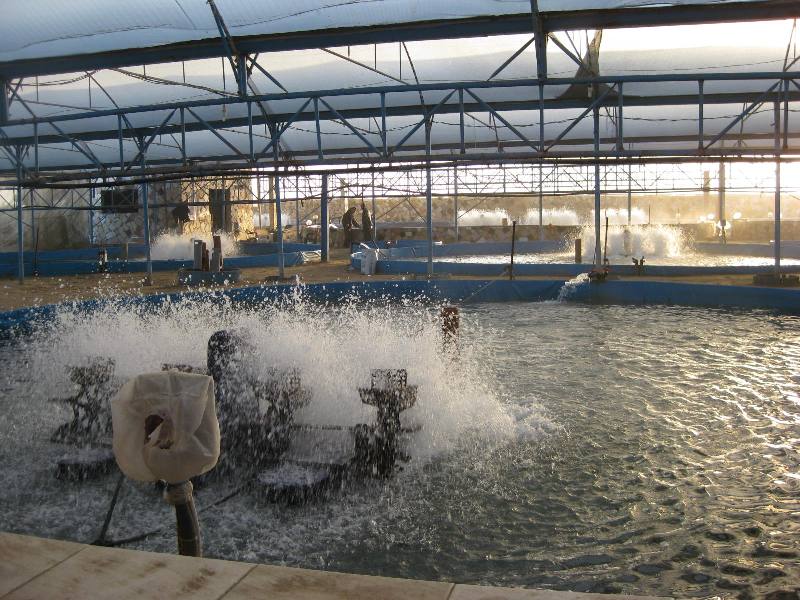
Patrons can attempt to net their own fish for their own dinner plate. I tried, as Prince Charming, Osama, and Arwa looked on.
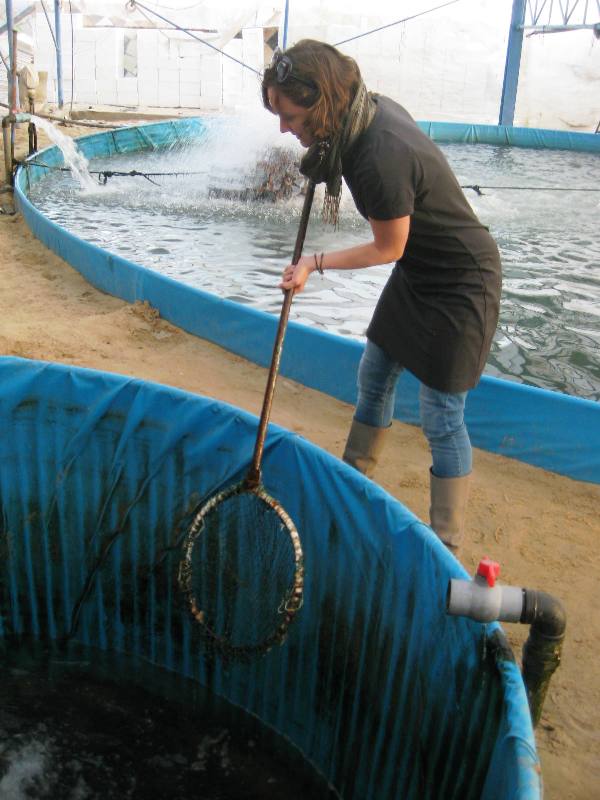
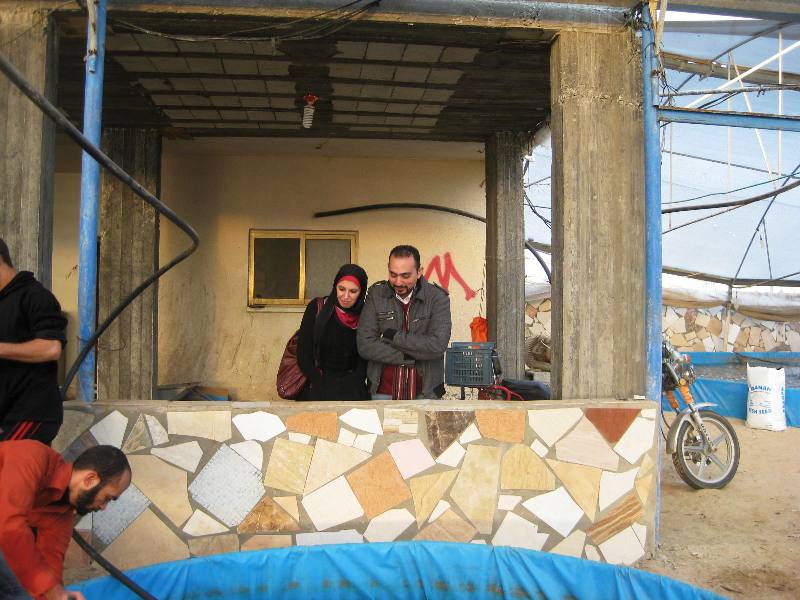
I failed. Osama said he'd never been successful either. One of the employees got down into the tank and netted us a couple of fresh fish, one of which showed up on my plate 20 minutes later.

We had a wonderful time chatting and laughing over dinner with Osama and his wife Arwa. Osama is a big fan of argila, which is a very popular hobby/habit/vice all over Palestine. It's also called sheesha, hookah, or, affectionately, hubbly bubbly. We laughed over the fact that extreme Muslims frown on women smoking argila in public because it looks suggestive. Of what? Oh dear, the culture is far too genteel for anyone to actually say what it might be suggestive of. I'll leave it up to you to guess.
Many thanks to Osama and Arwa for being such generous and warm hosts who genuinely seem to love their adopted home, (they are descendants of refugees) yet are honest, educated, and well-traveled enough to rue the fact that they are stuck in Gaza unless they can get jobs overseas. Osama would want you to know that his favorite meal in the whole world is Kentucky Fried Chicken, and he wants peace for many reasons, but partly because he really wants Gaza to get the franchise. He also speaks with enthusiasm about how resilient the Palestinians living in Gaza are. Seriously, I can hardly overstate how kind, hospitable, and tolerant Osama and Arwa are. I wish them the best and hope for peace and all the opportunities they could ever want for themselves and their family.
Ladies Brunch
Prince Charming's office in Gaza is majority male, and so the next day the few ladies at the office invited me to brunch with them at a restaurant in Gaza City overlooking the ocean. I always ask permission before featuring anyone on the blog (except men who attack the car in front of me) but a few of the women at the brunch didn't feel comfortable appearing here, so the only photo I'll show you is of the view of the ocean when it started raining in the middle of brunch.
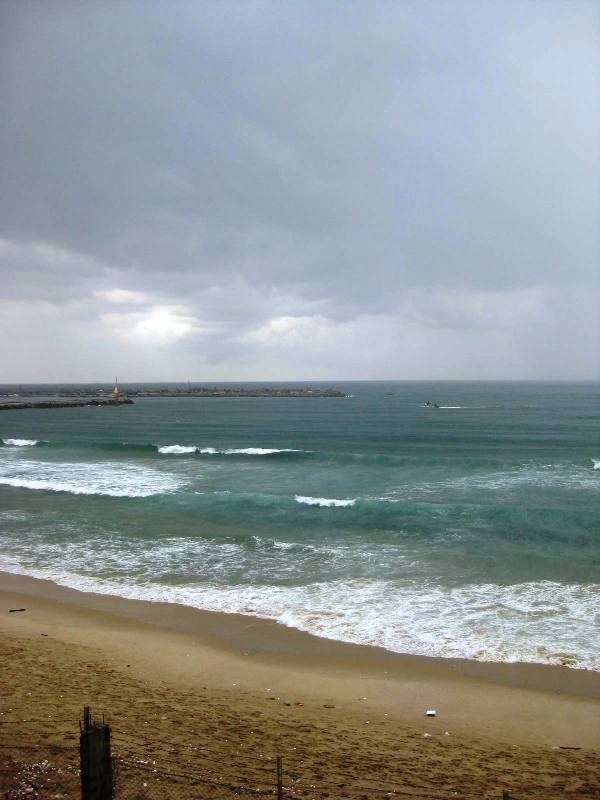
Apparently, it only rains a few times a year in Gaza, so this event was cause for great joy. The women got up and rushed to the window, opening it and putting their hands out to touch the rain. One of them told me "If you ask Allah for anything while it rains, he will give it to you." Another said that as a romantic, she loved to walk in the rain.
As you know, I'm coming from Ramallah, where it's been cold and rainy for weeks. I was surprised at their enthusiasm and then remembered how rare rain was in L.A., and how I'd felt a similar sense of blessing being poured from the sky when it rained there. I sat back and enjoyed the sound of the rain as it poured loudly on the roof of the restaurant where we sat warm and dry.
At the brunch, and several times throughout my visit to Gaza, I tried to find out about the details of the traumas and miseries of a) being in Gaza during the strikes, and b) being a woman in Gaza. My leading questions were not met with complaints or tales of woe. Lulu told me that the day after the ceasefire, everyone was arranging parties and gatherings. Osama drove by a group of men playing soccer by the beach and said "Is this resilience or what!" Others echoed those sentiments. The people of Gaza want to be happy and to have peace just like any other people in the world. They want outsiders to see that they are caring, strong, resilient, and hopeful. They try to see the blessing in the rain.
Exiting Gaza
Getting back into Israel from Gaza was a lengthier process than going in. We quickly passed through Arba Arba and Hamsa Hamsa, this time walking the kilometer from Hamsa Hamsa to the Erez terminal. (The tuk tuk wasn't around.) We walked through large turnstile doors, and then into a room with two large tables. The only direct contact one has with any Israelis during the process is with passport control. In this room, we couldn't see anyone, but Charming told me to open my bags and show them to a camera. The soldiers watching must have been okay with the contents of my bag, because a green light flashed on one of several entry doors, meaning I could go in. Charming and I entered a warren of small chambers separately. Nothing happened in my first chamber, except the light turned green, and I passed into a second, identical chamber. The red light turned green, but when I pressed the door, it didn't open. Someone uttered something in Hebrew that I didn't understand. I tried again, then realized I'd been pressing on the wall, not the door. I found the door, and it allowed me to pass into a luggage checking station. Again, I wasn't sure where to go, but when I looked up, I saw officials looking down on us from a glassed-in upper level. They motioned to me where I should go. Via this system of cameras, speakers, bullet-proof glass, and compartments, the Israeli officials are kept safe from would-be attackers.
We loaded our bags onto a conveyer belt, and another light turned green, allowing us to pass into the room where we picked up our luggage. We only had one more obstacle to get through: passport control. "What's your father's name?" The same well-manicured lady asked. I told her, and she said "What's your grandfather's name?" "Which one?" "You father's father." I told her, and she let me back into Israel. Charming's interview lasted much longer, about an hour. He and the nice-finger-lady chatted, and then he was sent back into the terminal to wait. Finally, after another chat, they let him through. His current passport/visa/paperwork situation is complicated and it took a while for the soldiers to ascertain the legitimacy of his papers. Once they did, we were free to re-enter Israel with a dual sense of gratitude and guilt for those we left behind.
Top 10 Food Blogs for Foodies
No post and email from me today, partly due to the insanity of tax day for my U.S. readers. In case you are checking, here's a consolation prize: Top 10 Food Blogs for Foodies from LifeScoop. Enjoy.
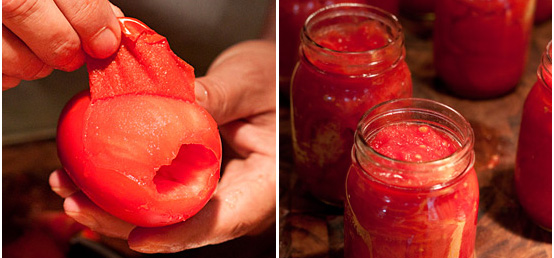
If You're Thinking of Starting a Creativity-Based Business...
I wrote this self-coaching guide for Fairy Tale Life (before I moved my creativity coaching to Packing Lust) to help you decide whether you should start a business as a writer, artist, photographer, performer, designer, or any business where you will be offering a product or a service that you create or co-create.
The outcome we are aiming for here is for you to make a decision to:
a) Start a creativity-based business as soon as possible.
b) Start a creativity-based business on a specific date in the future.
c) Not start a creativity based business at this time.
If you are considering starting a business with a partner, make sure both of you answer the questions individually, and then discuss your answers together.
THE QUESTIONS
1. Do I believe in myself?
I don't just mean this in a Disney musical sort of way. It's not just about believing you are a good person with talent. It's about trusting your ideas, skills, gifts, and ability to grow. It's about believing in yourself when no one else does.There will always be times when other people validate your work, but when those people aren't around, or when other people criticize, you are your most important validator and encourager. Can you find things to love about your work? Also, can you believe in your ability to persevere while you close the gap between the quality you aspire to and the quality you actually produce? This is the gap Ira Glass refers to when he says "It is only by going through a volume of work that you will close that gap, and your work will be as good as your ambitions."
2. Am I growth and learning-oriented?
The first place this applies will be in your market research, that is, in talking to and learning from potential customers, clients, or fans. Are you open to your business not looking exactly like you first envisioned? Can you learn about what people really want and need and apply those lessons to your business?
Can you build new habits that will at first feel uncomfortable or scary? Do you have the can-do attitude that is summed up in Marie Forleo's mantra "everything is figureoutable?" Do you love to learn about how to improve your work and your business?
3. am I sincerely focused on and committed to this idea?
In the first question, you asked about your belief in yourself. The opposite of belief is doubt, and self-doubt is a powerful killer of dreams. The best way to combat self-doubt isn't through willpower to stop negative thoughts, but rather, the willpower to focus on your art and your vision of your business as you build it. Once you've researched your business idea, and made sure there is a possible audience for what you do, you've got to fully commit and focus. Doubt will certainly come up if you are human, but your focus and commitment need to be stronger than that doubt.
4. Can I help people connect?
Seth Godin writes, "In the connection economy, there's a dividing line between two kinds of projects: those that exist to create connections, and those that don't."
As an artist, your job is to create the work. As an artist who is also building a business, your job is to help people connect over the work. Do you feel comfortable in this role? Can you answer questions, foster conversations, and reveal your process enough to make people feel connected to you? Will your projects create connections?
5. Can I make the space?
To run a business, you will need to make physical space and time space. You'll need to actively manage your time, which often means using a calendar. It means prioritizing chunks of time in which you will work with focused effort on your business. It means finding & paying for childcare if necessary. It means clearing out a room, closet, or other space where you will work.
6. Do I honor commitments to myself and others?
Danielle LaPorte says that the secret to success is to do what you say you are going to do. Of course, this is a high standard, and life is full of opportunities for white lies. (Did you really keep in touch with everyone whose high school yearbook you wrote in?) But language is powerful, and if people don't trust your words, or if you don't even trust your own words, then your business may falter. Can you keep appointments and be on time, or communicate clearly if you have to cancel? Can you deliver products or services when you state that you will? Can you stick to your policies even when they are inconvenient?
7. Am I open to suggestions and ideas without being overwhelmed by them?
There's a delicate line between being open to growth and opportunity and staying focused on creating your vision. You have to learn to walk that line. If you are too open to every new thing that comes into your landscape, you could get overwhelmed and creatively stuck. Yet if you shut your eyes to all new ideas, you may miss out an important life or business opportunity. Have you developed your own personal sifting process so that when new ideas come in, you can implement, discard, or save for later?
8. Do I have the support of a few people close to me?
It's true that not everyone in your life - or even in your family - may understand what you are up to when you choose to start a new business. That's okay. But I believe that you need to have at least one or two close friends or family members in your corner who believe in you and are cheering you on. Bonus points if your romantic partner is on board. You supporters will be there to give you pep talks when you lag, sympathy when the going gets tough, and ideas when you feel uninspired.
9. Do I have savings, a good bridge job, or some other way of staying out of debt while I build my business?
While businesses can grow quickly, it's common that in the beginning they cost more money than they bring in. And if you don't have a built-in audience that you've already cultivated, then give yourself plenty of time to gain fans or clients. In the mean time, you'll need a way to keep paying the bills. You could save up (the amount will vary depending on your budget and your business), you could keep working in your current job, or you could get a bridge job. A bridge job is one that covers the bills but doesn't drain your creative energy. It helps if your bridge job meets a need for you that your business doesn't. For example, if you are an artist who spends long hours alone in the studio, an ideal bridge job might be bar tending to meet your need to socialize. Your spouse or partner also might agree to take care of the bills for a time while you build your business. Finally there are artist communes and artist housing projects worth looking into where your cost of living could be very low.
10. Do I have a clear purpose in life that I know on a deep level and is this business connected to it?
I know, this last question is a doozy. But I believe that without a sense of purpose, life is less fun and less meaningful. I love how Mark Twain puts it: "The two most important days in your life are the day you are born and the day you find out why." Your purpose can be in a 10-page mission statement, or in one word, such as "love," but you need one and it needs to resonate deeply with you. Your purpose may change or evolve with time. Do you know your purpose? If so, how is your business idea connected to your purpose? Running a business takes as much time as you are willing to give it, and that time will be more fun and fulfilling if you can identify every day why what you're doing matters.
Let's Talk about Yesses!
How many yesses did you have? Did you say "yes" to all ten questions? If so, congratulations! You may be ready to start a creativity-based business! If not, can you work on turning any no's into yesses? If so, your decision can be to delay starting a business until a certain date in the future. I believe self-doubt can torture entrepreneurs, and is the greatest killer of new businesses and new ideas. I wrote this post to help you make a strong decision and vanquish self-doubt. Now that you've answered these questions, I hope that any doubts you have about your decision to start a new business are gone, and that you can move forward with confidence in your decision.
I wish you luck, fun, and magic in your new venture. Know that I am here cheering you on.
"Yessing" you all the way,

How to Be Where You Are When Wanderlust Distracts
So we just found out we are moving to the country of Comoros! Just kidding. April Fools. But for those of you who were thinking "What the bleep is Comoros?" Wikipedia's short answer is "a sovereign archipelago island nation in the Indian Ocean, located at the northern end of the Mozambique Channel off the eastern coast of Africa, between northeastern Mozambique and northwestern Madagascar." It also happens to be one of the globe's least populous nations, but one of the most densely populated. In other words, it's a tiny country packed with people.
Our Wanderlust
Okay, now that geography lesson is over, I want to delve into something personal -- our psychology of wanderlust right now. Charming and I moved to Palestine in May and June of 2012, with plans to stay for the duration of Charming's two-year contract with his organization. Beyond two years, our stay was and is unknown. So that means in just a few months, we enter unplanned territory. And something weird happened to our mindset. It's weird and also weirdly familiar. When was the last time I had this feeling? The summer after my senior year of high school.
Spoiling the Nest
Let me start by saying that all of high school was an emotional roller coaster for me (and for everyone, I know) but I remember that by the time I graduated, my roller coaster was decidedly uncomfortable. I felt completely done with my hometown, my family, my friends, and anything I could possibly do for fun. My mom called it "spoiling the nest," and I certainly was. I was irritable and quick to complain. I lashed out and put distance between me and my loved ones. I was a bird who was ready to fly, but knew that to leave the comfort of the nest I had to convince myself that it was a boring place filled with stupid people. I needed the place and people to prove their negative attributes so that I could feel justified in leaving. I love my family, and my hometown is filled with dear friends. So those things I harped on weren't true, but my subconscious started to make them feel true, so that when the time came to leave, I didn't hesitate.
Similarly, I noticed I have been complaining more than usual about Palestine. I've been snarking on the repressive atmosphere, the constant harassment, the shoddy business standards, everything right down to the broken hinge on our toilet seat. Even though I can find those things everywhere in the world, if I look hard enough.
The Wanderlust Timer
Nothing seemed fun or worth doing for a while. I racked my brain. What was wrong? And then I realized it. I was spoiling the nest. Even though we have no plans to leave this place, my brain had been thinking two years, two years, two years, for so long that it was like a timer started going off when two years approached. A timer that said, "Ok, prepare for the train to leave the station." The wanderlust timer.
But the truth is, we may be here for a while longer. We don't know. The widening chasm between my geographical location and my mental location called for a recent attitude shift to bring them back to the same place.
Getting My Joie Back
I did four things to get my joie de vivre back and get back to Palestine mentally, instead of being here and not being here.
1. I talked it over with some friends and realized what was going on.
2. I imagined that we made another two-year commitment here. What would I do? What new places would I see, activities would I try, friends would I make?
3. I centered by focusing on my deeper purpose in life which I can live out with enthusiasm absolutely anywhere in the world.
4. I took action on a couple of things relating to #2 and #3 and put some new adventures into motion. (With help from my friends.)
I think these steps or some variation of them could be helpful if you find yourself drifting to some other place mentally and that drifting is making your current location or job or relationship seem not quite the romantic place it once was.
What do you think? What do you do when you need to enjoy where you are a little more? Please share in the comments.
What's Next?
When our friends and family ask "What's next?" I really like being able to give a concrete answer to that question. But the truth is, we don't know right now, and we don't know how long we won't know.
So for the time being, I'm focusing on enjoying my springtime nest right here in Palestine.
All Are Valid
I'll close with this excerpt from Mark Manson that I read and enjoyed today. It's from his essay "Wanderlust."
"The more places you go the less any single one is likely to satisfy you. As with any purely external form of satisfaction, there’s a cruel diminishing returns to it. Yesterday’s exotic is today’s bore. Yesterday’s news is today’s history. It’s the core of any addictive behavior: you need more and more and more, until one day you need less. Or even worse, you die never having known enough.
The more you see and experience, the more you see the overlapping of personality across culture, you see the universality of daily human existence, the common denominator of nature, and you understand that joy and relationships too, are location-independent.
You (hopefully) begin to understand the reward for any journey must be the journey itself or nothing at all — the moments of airport tedium as well as the exaltation of the world’s highest monuments; the anxious anticipation of the unknown as well as the jaded boredom of routine; the vanity of indulging in prestige and class as well as the humility of the living among the most downtrodden and unfortunate. All are valid and necessary. All are their own steps upon the same path of your life."
- Mark Manson
Can You Be Minimalist With Kids?
Or is your house destined to look something like this during your child-rearing years?
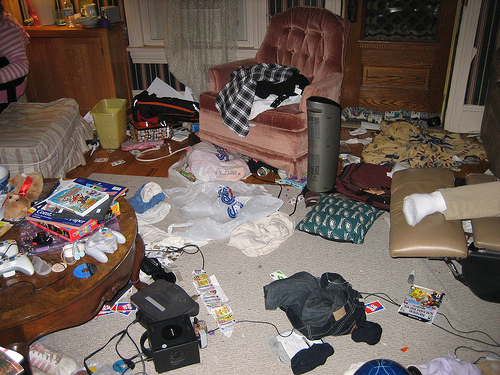
Since publishing my book, Minimalist Living, and a few times pre-publication, I've gotten questions about how to live a minimalist lifestyle if you have kids. I didn't get into that topic in the book because a) we don't have kids yet and b) people willing to say they are successfully living a minimalist life with kids are few and far between.
From everything I've heard, the results of procreation are unpredictable. There's no way to know if you are going to give birth to neat-freak matching-sock-wearers, or if you are going to have a bunch of aspiring splatter artists. And if it's the latter, I'd be the last to tell you to crush their artistic dreams.
So let's turn to a minimalist parent who can speak to this mystery. I'm publishing portions of an email she sent on the topic. Thanks so much to this anonymous parent who wrote the following.
Moving as a Method to Keep Clutter Minimal
Our situation over the past few years has really necessitated that we keep the clutter down, but I don't know if we would be good at it otherwise --We have dealt with three overseas moves for one-year positions, and each time we've mailed maybe one or two boxes mainly of [my husbands] books and papers, and everything else we brought had to fit into suitcases. We were always moving into furnished places, so they came stocked with just the basics-- dishes, cooking things, bedding, towels, so we were bringing clothes, things we needed to work, like laptops, and a few favorite toys for the kids. If we were in Europe coming back to the US or Canada, we also brought lots of books in German or French, as they would be hard to get here, and we want to keep up the kids' language skills.
Traveling with the Maximum
I have to admit that we never really mastered packing light after we had kids. Once or twice, when it was just the two of us, we traveled to Europe for a couple of weeks with just a regular-sized backpack each (the school kind, not the camping kind), but for our longer stays with the kids, we brought as much luggage as was allowed without being charged extra, and it was always a disaster because it was more than we could carry and especially tough to get on and off of trains when traveling from the airport to whereever we were living, especially when dealing with 3-4 small children, always a stroller, and once with both one in a stroller and one in a baby bijorn. But it always made us realize that once there, we really couldn't accumulate any more stuff since there would be no room to bring it along, but I found I have really enjoyed minimalist living, and having less toys and kid stuff does mean less trouble cleaning up.
What to Do About Toys
Now, we are still in a temporary situation, but instead of the furnished rental places that were our last three places to live, we are renting a home from a family on sabbatical, so much of their stuff is still in the house, (which they've lived in for years as the three kids have grown up), including so many toys--it's impossible to keep up with it! In contrast, from 2010-2012, my kids' main playthings were a bunch of duplo legos and some small stuffed animal toys. But it was always enough to keep them entertained-- everyone liked to build things with the legos, and there were enough of them that everyone could have a project at once if they wanted. Usually the boys would build vehicles and then play with them. My older two children (now 9 and 7, but when we first moved in 2010 would have been 4 and 6), had about 4-5 beanie-baby sized animals and liked to act out imaginative stories with them, narrating their actions. Those two activities, plus reading and coloring made up just about all of their indoor activities and was really all that was needed. Now that we have the use of the extra toys, they get strewn about, but not really played with as much.
Celebration Giving
Gift-giving times like Christmas and birthdays are hard because I really want the kids to get to open gifts they are delighted with, but I dread having the extra stuff. Foreign-language books (and movies) are always worth it, so that they could keep up with their language skills, we felt they were worth stocking up on (and probably took up most of the luggage space on this last move). I always try to think in terms of consumable gifts, like arts and crafts supplies, or things that are so inexpensive we don't mind leaving them behind. If the grandparents are visiting for Christmas or something, I also give them strict instructions about what they're allowed to bring as gifts, and I always try to send them back with as much stuff as they bring-- for example, clothes that can be handed down to another kid or books we can save for later.
Pretend to Move Once a Year
I guess this doesn't really help someone in a situation of living somewhere permanently and wanting to control clutter-- they wouldn't be forced to give it up at the end of the year. Based on my experiences, my advice would have to be, "Once a year, get as many of your possessions as you can into one suitcase and one carry-on per person, and get rid of the rest!" but that's pretty impractical, and I'm sure I wouldn't do it if I weren't forced to. But I think I have probably become a lot more thoughtful about things I acquire, thinking ahead to what are we going to be doing with this thing a year from now -- do I really need it?
A Helpful Chant
When doing big clean-ups, I have to chant, "when it doubt, throw it out!" I think I tend to want to be a pack rat and save things, so it can be liberating to know you have to throw things out. My husband really wants to save every bit of artwork the kids produce - so much for the "consumable" art supply gifts! But really, all the pieces worth saving can fit into a large envelope. We just don't buy a lot of stuff (it's not really in our budget to, anyway), and I instruct Grandma not to, though it's hard for her!
Buy Second-Hand and Then Donate Again
When we lived with no car, we could walk anywhere we needed to go most of the time because [it]was such a small town, but something like a Wal-mart was a drive away. So if I needed something that would usually call for that kind of store, I'd first check out the local Salvation Army Thrift Store, which had a decent selection and the things there were pretty nice (I checked out the one near where we presently live, and things were not so nice!)-- for instance, I picked up an iron and ironing board for probably under $10 total, so it wasn't difficult to donate it back to the thrift store when we had to move.
When Grandmothers Get in the Way
Anyway, I had the younger kids with me all the time, and the thrift store also had toys, and my daughter would always pick out some stuffed animal that she badly wanted-- a large unicorn for instance, and even though it was only $1.99 or whatever. I'd say "no, we don't need that" realizing that it would become a precious friend that couldn't be left behind but wouldn't fit in a suitcase, and I'd feel pretty relieved that I had a good excuse not to have to bring the thing home. But on two different occasions, kindly grandmotherly types overheard, felt sorry for her, and came up and gave my daughter the money so that the poor girl could buy herself the huge unicorn or horse or whatever. Noooooo!
How to Get Your Kids to Part with Toys
We solved the problem at moving time by having a little girl friend of hers adopt them and promise to take good care of them, so it all worked out-- she got to have a couple of months of playing with them, and it wasn't so traumatic to part with them.
So, to those of you with offspring in their younger years, what do you say? Is it possible to live as a minimalist? Let us know in the comments, and PLEASE share any tips that have been helpful to you in this area (even if you aren't perfect or even close ;).
For more on this topic, join the free 10-Day Decluttering Challenge and associated minimalism email series.
photo credit: AngryJulieMonday via photopin cc photo credit: pricecs via photopin cc
Top 10 Best Websites for True Creativity
I typed "what is creativity?" into the Google, and this is what it said:
The use of the imagination or original ideas, esp. in the production of an artistic work.
To some extent, we each have our own definitions of creativity. Those of us in creative professions may have our own unique set of rules, superstitions, ceremonies, and special pants to protect and nourish our creativity.
Getting it Out There
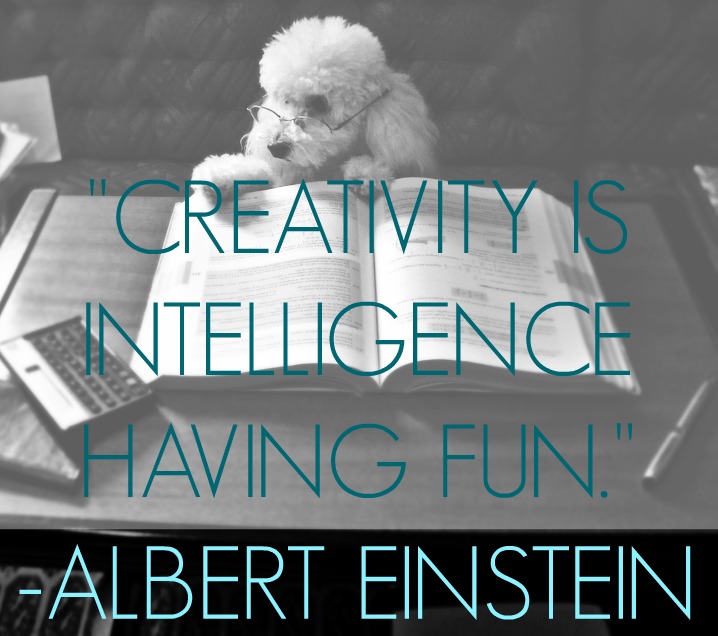
So what do I mean by "true creativity?" Well, I mean what I think is important to be truly creative. For me, true creativity emphasizes the production part of the definition. And I would go even further to say not just the production part, but the getting-it-out-there part. Because if you are all alone in your house being creative without sharing it, you are the only one who is going to benefit. And you are WAY too big-hearted, brave, and selfless to let that happen.
Criteria
The criteria, therefore, to make my list of top 10 websites for TRUE creativity included not just inspiration (although a couple are pure inspiration) but also encouragement, education, and channels for distributing the things you create. Because, again, creation without an audience -- creation without benefitting others -- is like having a child and then never letting it grow up and experience the world.
Some websites masquerade as pro-creativity sites when really, they are just pro-crastinativity sites. (And yes, I made that word up for phrasal symmetry.) Intentions might be pure, but these sites waste your time, make you feel bad about your own creative production, and then, in the worst cases, use your weakened emotional state to sell you things you don't need. Yuck. I've filtered all those out for you. You’re welcome.
The Top Ten
Here are the topic 10 best websites for true creativity (other than this one, of course) along with their highlights and an idea-suggestion for how to use each to get you going on your creative way.
Highlight: This online magazine covers what's new and modern all over the design world: art, architecture, fashion, interior design, and technology.
Idea: The best sources of ideas are almost never in your field (you risk copying someone else there). So if you're a fashion designer, try looking at their architecture section. You might just find yourself inspired by the lines and colors you see there.
2. COLOURLovers
Highlight: This community of color fans shares palettes and patterns inspired by a wide variety of sources, including magazines, weddings, and Japanese art. Since I'm obsessed with color myself, I can't help but sneak in a link to this amazing article on Creative Bloq that shares 27 other online color tools. I could spend all day just looking at colors and palettes.
Idea: The colors and palettes are each given creative names by community members. Maybe you're writing song lyrics and you need some inspiration for how you're going to sing about the color of your lover's eyes or the sky. How about "lime fusion," or "moonage daydream"?
Highlight: There are a lot of websites out there aimed at helping self-publishing writers promote and sell their work. But Amazon Kindle Direct Publishing is the only program I've experienced significant results from. The program is free, easy to use, and in most cases, authors can earn 70% royalties while tapping into the marketing powerhouse that is the Amazon website. Through their KDP select program, I've been able to reach over ten times the amount of people I would normally be able to promote to. That means my book is actually out there in the world, even though I haven't spent a lot of time touring or promoting through blogs.
Idea: See just how easy it is to use by publishing one chapter of your book via KDP. Once you convince yourself just how easy it is to reach an audience, you'll be more motivated to finish your novel and start selling it.
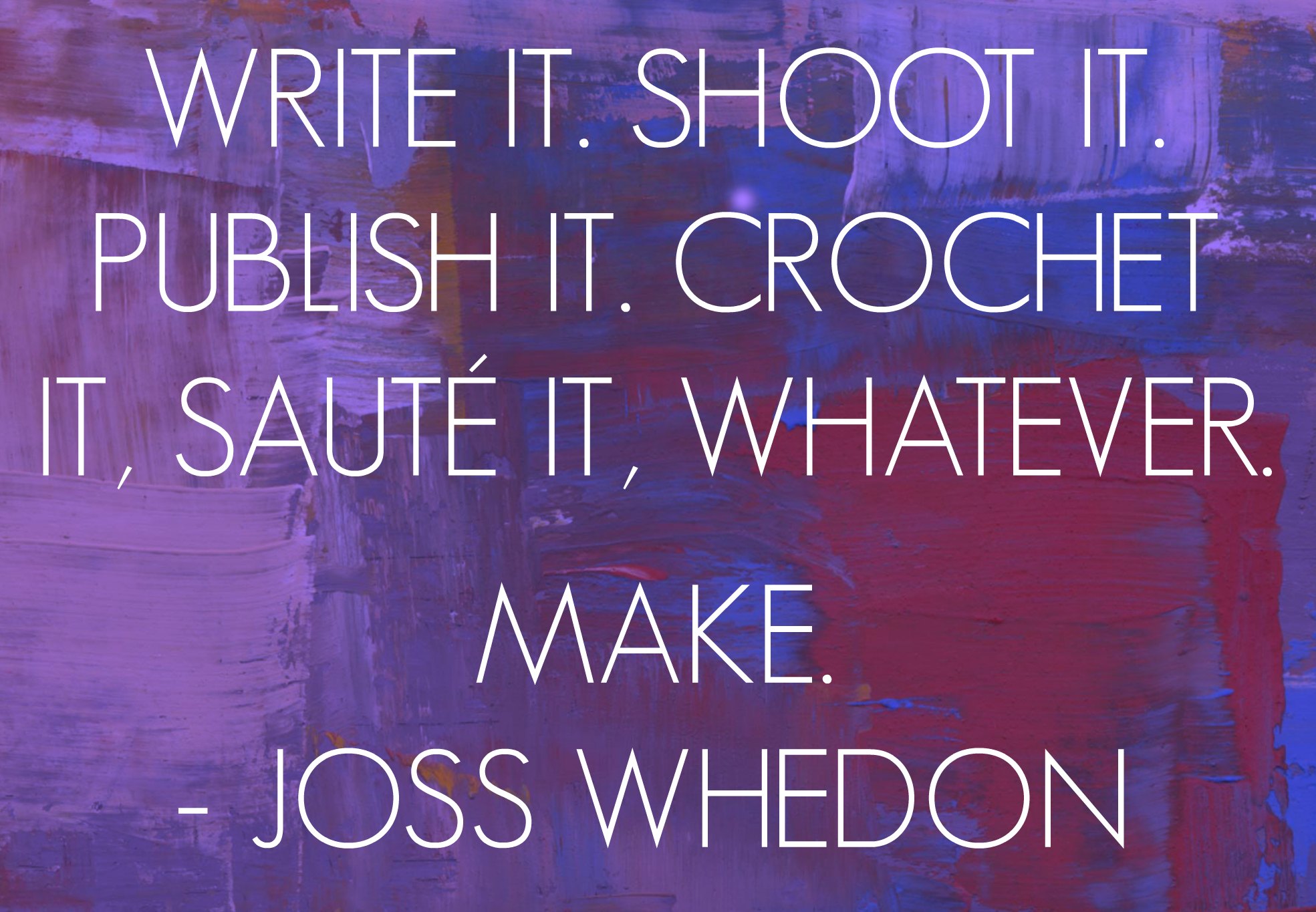
4. Pinterest
Highlight: Pinterest may be the world's best collection of visually-presented ideas. If you are a visual or curatorial person, odds are you are already on Pinterest. If you're not, get ready to sacrifice at least the next three days and nights to this addiction.
Idea: Maybe you're a film set designer. You could click on the "home decor" tab to instantly see incredible designs and atmosphere. And any other idea you could dream of.
5. ARTtwo50
Highlight: This brand new app allows people to virtually hang your visual art on the walls before buying it. And it markets and promotes the work of artists who sign up. I know so many artists would take a bullet before letting the words “business plan” come out of their mouth. Until ARTtwo50, that meant starvation or tending bar.
Idea: Use the app as your imagination puts you in the shoes of the people who buy your art (or who you visualize buying your art). See what they want and what they need. See how it’s going to hang above their couch. Hopefully that inspires you to make something that will make their life better.
6. Times Haiku
Highlight: Jacob Harris at the New York Times created an algorithm that automatically detects haiku which occur within the paper's articles. This Tumblr blog features the human-selected best from those naturally occurring haiku the computer program finds.
Idea: Revisit Times Haiku when you need a writing or creativity prompt. Could this haiku:

inspire a short story, or even a novel? What about a painting?
7. Etsy
Highlight: This online market place is the first spot to check out if you want to buy or sell handmade or vintage items.
Idea: Use the Collections feature to get atmospheric inspiration for anything from a poem to plating your latest culinary creation. Or just use it to get your own creations out there!
Highlight: FvF is an online magazine that shows creative people all over the world in their working environments, studios, and homes.
Idea: There's something inspiring about seeing artists in the space where they make things. Next time you feel self-doubt, just take a peek at FvF to be reminded that people all over the world are creating and you can too.
9. TED
Highlight: TED is a nonprofit that started with the goal of spreading ideas in the areas of technology, entertainment and design. Now it's become synonymous with videos of compelling and inspiring talks on just about any idea worth spreading.
Idea: I suggest watching TED talks when you need encouragement, motivation, or inspiration, because they tend to fire you up enough to get you back on track with YOUR projects. It's not an endless rabbit hole, with one video leading to another until you suddenly realize it's 2 AM. I usually can just watch one or two and then am able to apply an idea to my art or life.
Highlight: Writer-Artist Austin Kleon combines writing and visual appeal in his pieces, giving him unique authority to talk and write about the trans-mezcla nature of creativity.
Idea: If you haven't read his book, Steal Like an Artist, you should. In the meantime, check out his blog where he provides pithy and encouraging advice on the creative process.
BONUS!
11. Any Website That Makes You Laugh
Highlight: This website tickles your funny bone; it always seems to have a video or joke that cracks you up every time.
Idea: Visit when you feel creatively stuck. Laughter decreases stress, increases blood flow, increases positive brain chemicals, and can help improve creativity.
Did I miss a website that is in your top ten? Tell me which one and why in the comments.
Image credits:
1. See-ming Lee 李思明 SML via photopin cc (image altered).
2. betta design via photopin cc (image altered).
Dry Wanderings
We spend the last two weekends in February exploring nearby places that are just too hot and dry to enjoy during the arid summers here. The first weekend, we went down to...
The Negev Desert
Vision: Emotionally fulfilling stargazing and life-changing desert sunrises.
Reality: Overcast skies, dull clouds, freezing winds, and light drizzle.
Before we left, when we confirmed that the forecast was going to dash our star-gazing dreams, Prince Charming asked me if I thought we should still go.
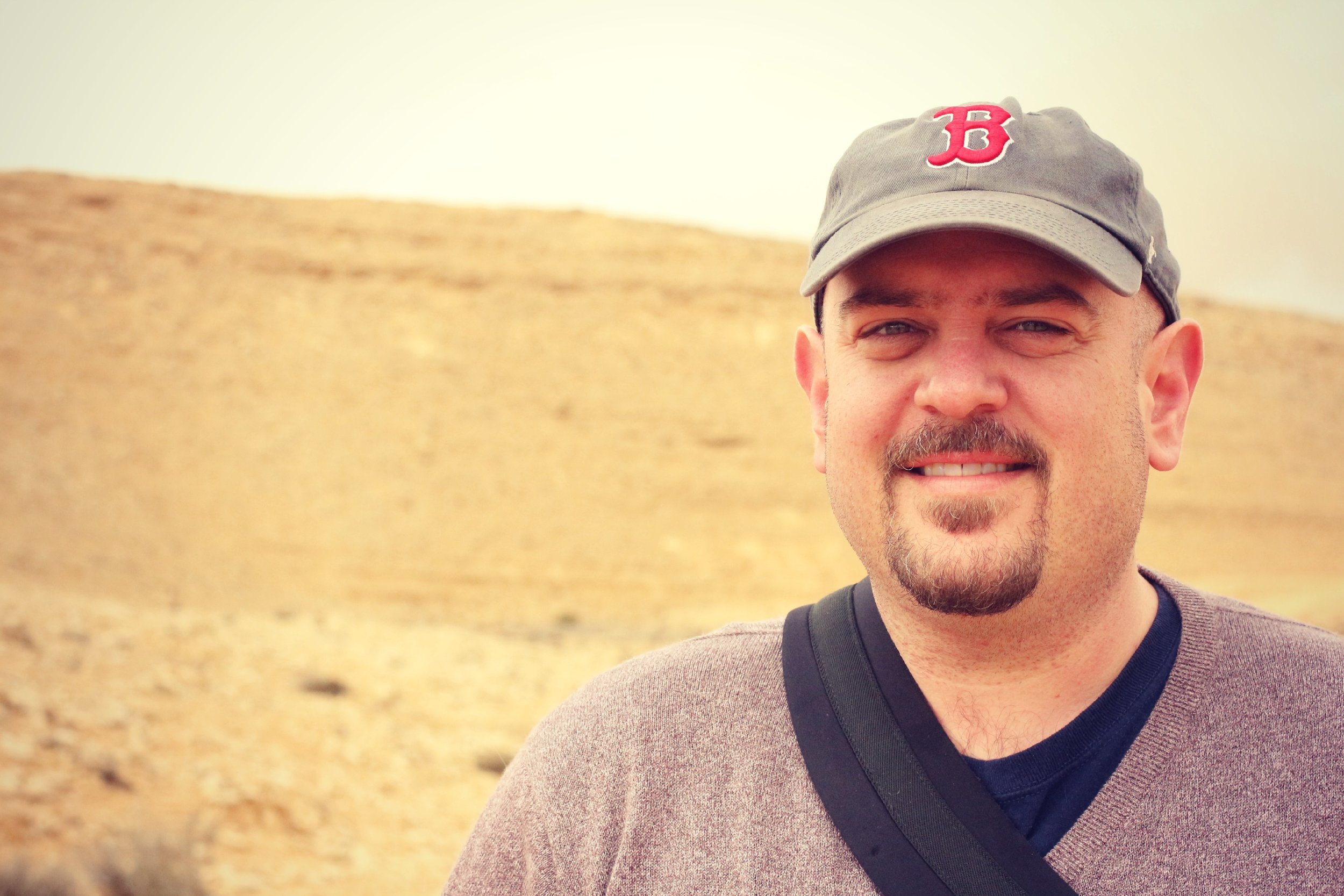
"Yeah," I said. "We'll go and have fun despite the weather."
And we did. It was cold and the skies were lugubrious, but there was something charming about the town of Mitzpe Ramon, Israel. It's a small outpost that has attracted a combination of hikers, outdoor enthusiasts, and eccentric artist types. And you know how much I love eccentric artists types. Charming and I always feel comfortable in places inhabited by eccentric artist types. And I also love outdoor enthusiasts. So I felt right at home.
I took this picture in Mitzpe Ramon. It's a bicycle (outdoorsy type thing) that has been covered with white fuzz and turned into a permanent art display (eccentric artist thing to do).
Here's the rest of that art installation:
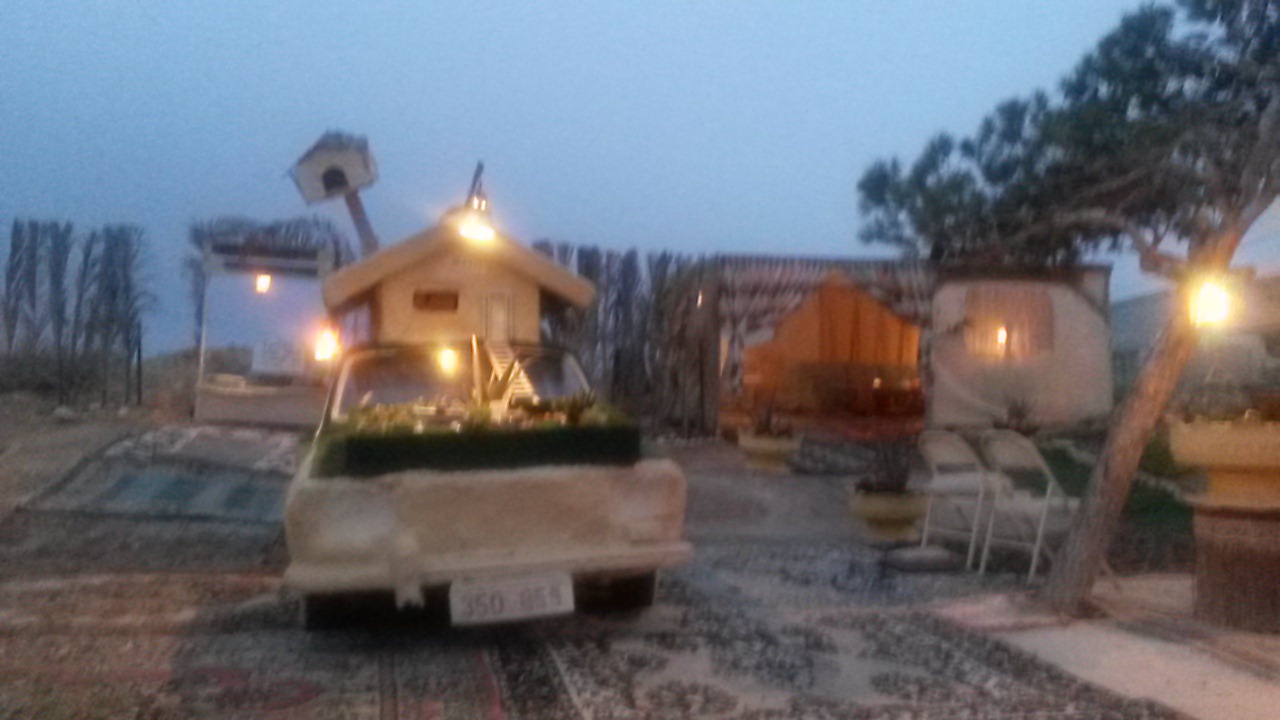
I think it's impressive that Mitzpe Ramon has attracted anyone at all, considering that its claim to fame is a hole. A very large hole in the ground. We couldn't find the hole at first, so we drove around, asking each other do you think the hole is over there? Could it be over there by those nice apartment buildings? Maybe if we follow the sign that says "visitor center."
Then, after a frigid walk/jog up an incline, we came upon the hole.
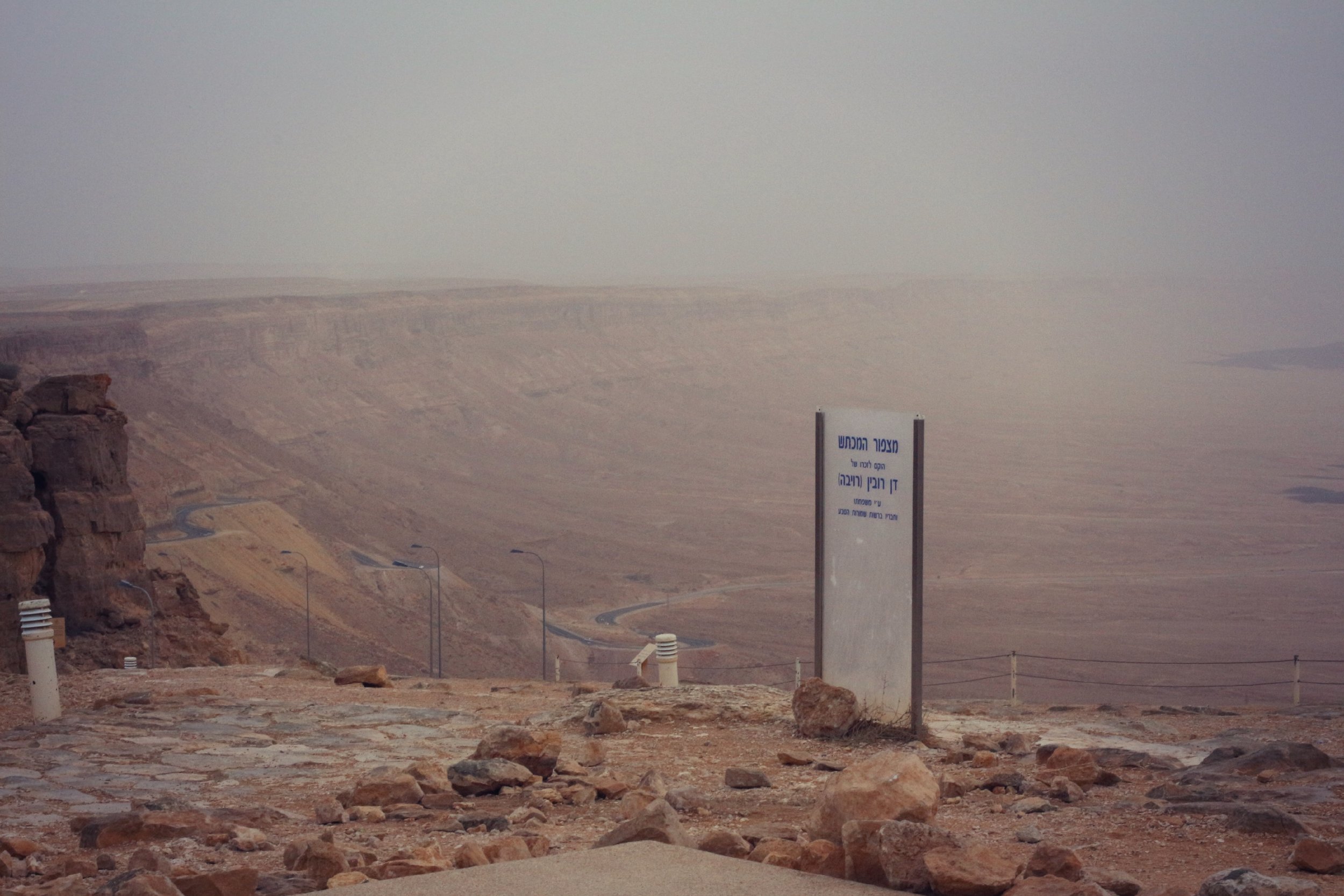
According to TouristIsrael.com, this hole is the world's largest erosion makhtesh. Makhtesh is often translated as "crater," but that is misleading since this hole wasn't caused by an explosion or the impact of a celestial body.
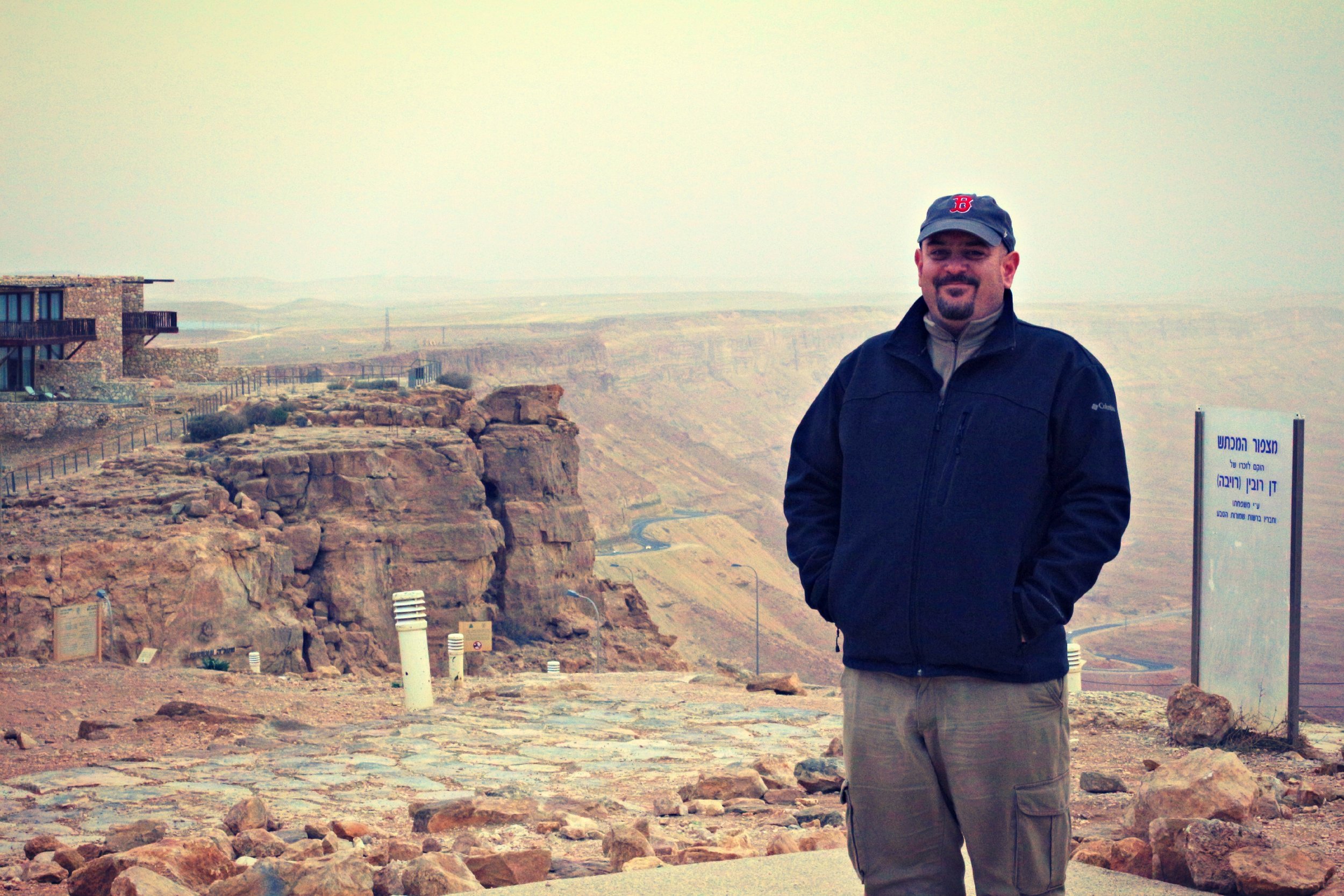
A better translation of makhtesh, perhaps, would be "erosion circle," or, "big ol hole." Geological forces created this superlative wonder some 220 million years ago.
It was pretty chilly on top of that hole in February.
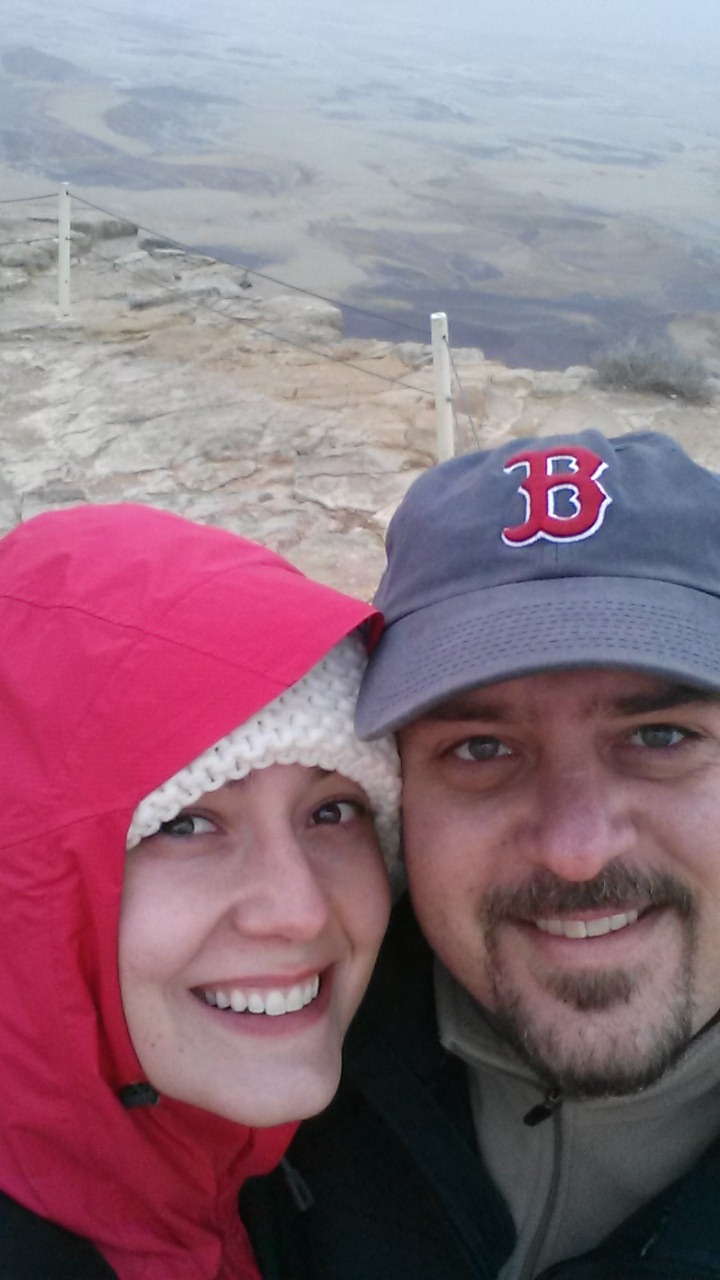
Here's a photo (from the Shalom Israel Tours website) of the hole on a better day.
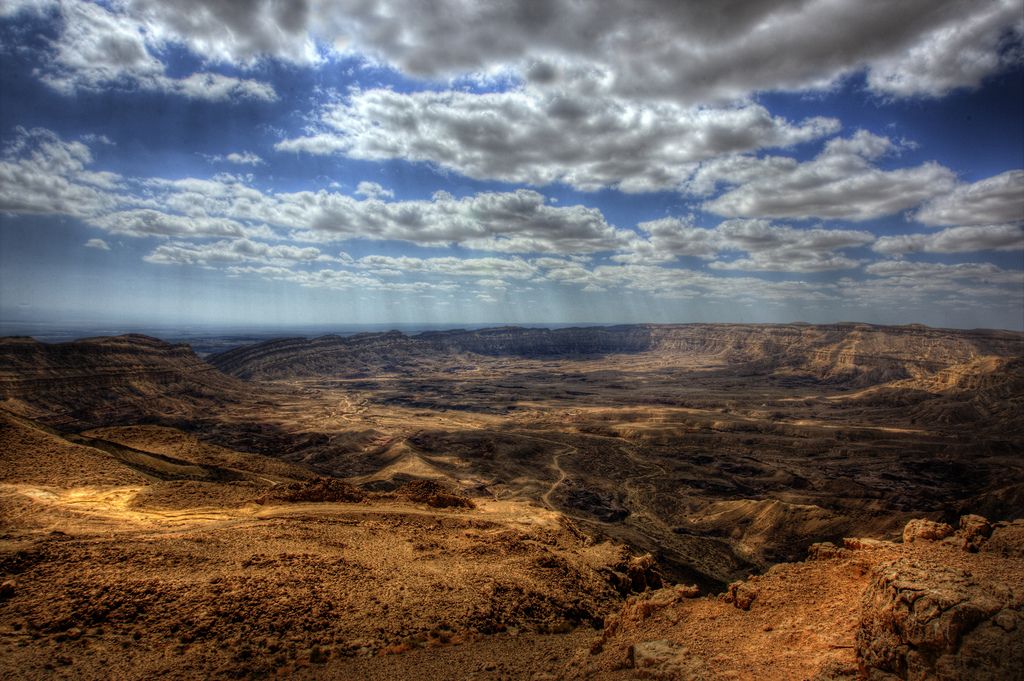
We stayed at a desert-hostel-camp rather chillingly called "Silent Arrow." The place was so hipster that it had an ironic jacuzzi.
It also had a friendly owner and volunteers, and a great vibe. We stayed in one of these tents:
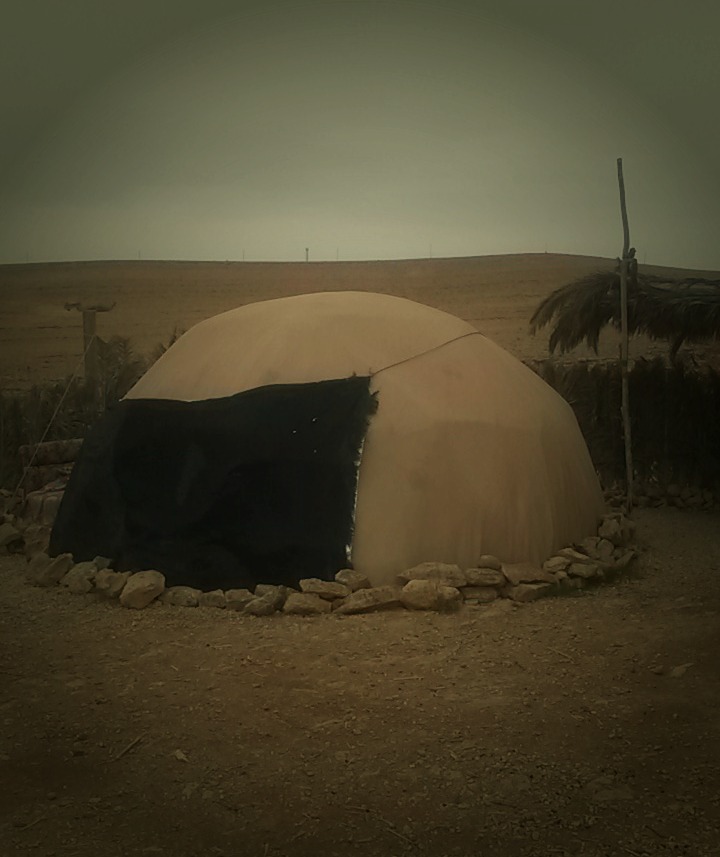
wadi qelt
The next weekend, we decided to do some hiking in one of the longest and most famous valleys (wadis) in Palestine: Wadi Qelt. To hike the whole thing from Jerusalem to Jericho takes about 10-12 hours, depending on the weather, your speed and your fitness level. We wanted the gentle stroll version, so we just drove around until we found an entrance (we knew because there was a tour bus, a camel, and some bedouins) and started walking around. We started at the top of the wadi. By the way, my vision is that I can always get my dog to look at the camera. Reality:
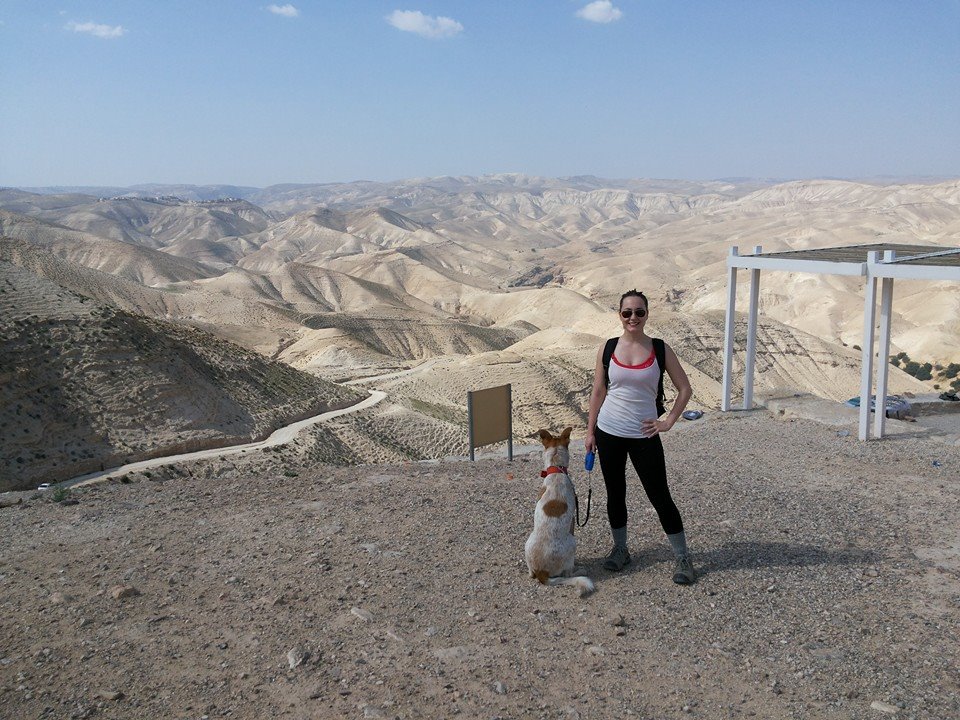
After photos, we drove down into the wadi. That is, Charming and I rode in the car, and we made Jelly run behind us. She needed the exercise.
Once almost to the bottom of the wadi, we got out and hiked around. At the very bottom of the valley, we heard the delightful sound of bubbling water, and followed it to this narrow aqueduct:
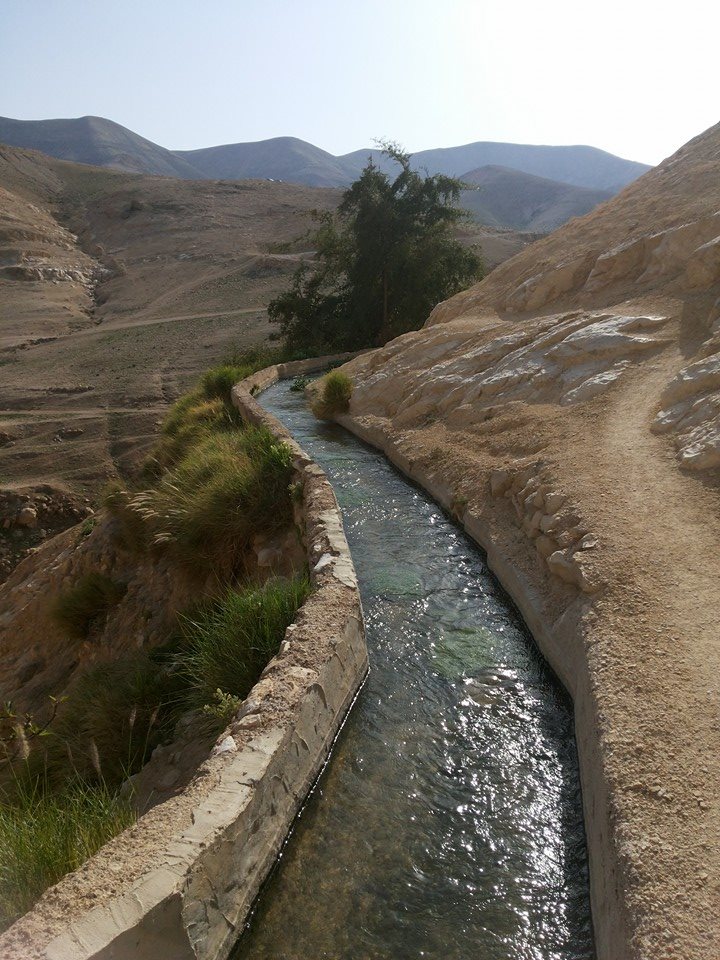
We found a green spot amidst the brown for a nice picnic lunch.
One of the most famous spots in the Wadi Qelt is St. George's Monastery. But by the time we got back to the car and drove to the monastery, we were tired. We quickly became discouraged about the amount of energy it would take to run the gauntlet of hyper aggressive bedouin jewelry sales representatives at the entrance to that section of the park. So we went home. We'll have to save St. George's for another day, or just enjoy photos of it online.
Most of the time when traveling, things don't turn out the way you think they will. Although neither of these trips turned out perfectly, they had unexpected joys.
What about you? Do you have a traveling story where things didn't turn out quite like you expected? I'd love to hear it in the comments.
My Love Note to Juthour
I was recently hiking at Juthour, an arboretum eco park on the outskirts of Ramallah, Palestine. It was just before sunset, and this February day was especially stunning. The air was clear and warm, but the earliness of the season meant there were no annoying bugs out yet. We could see clearly for an especially long distance all the way to Tel Aviv. As I walked up the hill with a couple friends, chasing the sun before it sank down into that western hillside, I thought of how grateful I am for Juthour's existence. My gratitude quickly turned into a desire to help Juthour grow, since I know that the land Juthour protects is under constant threat of development, bulldozing by Israeli extremists, poisoning by shepherds who fear the wild boar, and toxic construction waste dumping. Whew, that is a laundry list of threats to this beautiful land:
When I told Morgan, one of the co-founders of Juthour, about my urge to help preserve this piece of land, she suggested I write a blog post about it. So here is my little love letter list to Juthour.
My gratitude is especially deep when I think about these nine special attributes of Juthour:
- It's on one of the last undeveloped hillsides near Ramallah, so I don't see or hear construction noise as I enjoy nature.
2. It's proximity to where I live in Ramallah means that I don't have to make a day trip of it, and plan a hike only for special occasions. I can zip out there any time for a quick hike.
3. I can go with friends or alone, and feel safe because the friendly park rangers are frequently in the arboretum, and they expect to see me.
4. I can run on the dirt road around Juthour with my dog, without fear that people will stop and try to steal my dog because no one drives on this quiet dirt road.
5. Not only is there already an incredible variety of trees, flowers and birds at Juthour, but the park rangers are always adding more botanical treasures to this eco-park.
6. The park founders take action by reporting nearby illegal construction dumping, so I know that there won't be huge piles of trash around my hike, like there are in other hiking spots around Ramallah.
7. Juthour (which means "roots" in Arabic) is being preserved so that people can learn about and enjoy Palestine's natural beauty, so I feel welcome there as a hiker.
8. The park founders are dedicated to peaceful, non-violent resistance of the Israeli occupation of Palestine, so I'm supporting a good cause by supporting Juthour.
9. I can be inspired by the founders, who are resilient in the face of setbacks. I know when and if the Israeli government or extremist settlers destroy the trees in the park, the founders won't give up on saving the land, but will start planting the park all over again, always in a sustainable way.
I hope this natural treasure continues to grow and thrives so that Palestinians, expats, and tourists alike can enjoy the incredible sights and sounds of this special place. Are you a hiker and nature lover? Like the Juthour Facebook page to show your support for the eco park.
Top image credit: Juthour Arboretum. The others are from my Instagram feed, which you are welcome to follow.















 8.
8. 



